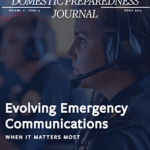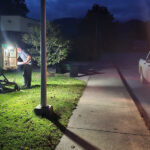Various drills and exercises highlight efforts to protect communities against various types of attacks involving transportation, buildings, historic sites, sporting events, and so on. Attacks and hostage-taking incidents around the world expose vulnerabilities that need to be assessed in all communities to determine: what they need to drill, who they need to train, and how they will collaborate across jurisdictions.
Regardless of the weapon used, active shooter situations are dynamic and evolve quickly. An individual or multiple attackers are actively killing or attempting to kill innocent people. Frequently incidents are over before arrival of law enforcement, forcing individuals to be prepared both mentally and physically to deal with an active shooter situation prior to law enforcement arrival. In other cases, only the immediate deployment of law enforcement can stop the shooter to mitigate harm to potential victims.
This paper shares key observations and issues from drills, exercises, and trends influencing preparedness strategies for active shooters and evolving threats. Venues discussed include: jurisdictional and inter-jurisdictional response; special events, including amusement parks and professional sporting events; and coordination with the private sector, including commercial and retail property managers.
Drills & Exercises to Identify & Close Gaps
Imagine an active shooter exercise at a regional light-rail station near a city and county border. About five minutes before the start of the exercise, a sergeant, a lieutenant, and a senior patrol officer are huddling. They realize they never met before, but more importantly, the three jurisdictions never compared entry policies, which it turns out are all different. In this amazing pre-event moment, professionals realize they need to get their response units together for inter-jurisdictional planning. Later during the exercise, there is a simulated shooting with an officer down. The effect of the “shooting” and lack of common response causes hesitation and costs time. The “shooter” uses that hesitation and delay to cleanly get away. For the next several hours, responders search but never find the shooter (until the after-action hotwash).
This simple exercise was real and serves as an introductory example of the value of exercises. Professionals of various experiences and perspectives are pressed within an exercise scenario representative of what they might experience in real life, to find uncertainties or inconsistencies that create operational pause or hesitation. That pause in decision-making and action – to consider the “right decision” versus alternatives across conflicting policies, plans, procedures, and assumptions – can cost lives.
It is critical to learn and apply insights from real-world events. Following the response to the 2013 Washington Navy Yard shootings, the public safety community actively addressed shortfalls, practiced drills, and exercised various scenarios to enhance response. As a result, the Metropolitan Police Department’s (MPD) response to the 2015 Washington Navy Yard lockdown was significantly enhanced. MPD had more weapons, enhanced capabilities on the street, and changes in tactics and procedures that resulted in a much faster and more effective response force.
Following a series of school shootings, extensive focus and efforts were applied to the safety of schools and community facilities. Law enforcement and public safety communities actively collaborated with schools to enhance safety including resiliency measures, coordination procedures, and lockdown strategies. Since that time, tools and resources continue to evolve and changes in key personnel have occurred. It is easy to become complacent. Drills and exercises leveraging new technologies and tools offer opportunities for continued collaboration between public safety and schools to support renewal and help achieve the next level of preparedness.
Special Events Planning
Moving beyond scenarios within daily activities, special events including entertainment, amusement parks, and professional sporting events provide significantly increased challenges. Magnets for large crowds, these types of venues present challenges on multiple levels, including: the role of private sector decision-makers and stakeholders; the need to quickly identify and apprehend or end the threat; and the scalability of response planning and capabilities.
The sporting, entertainment, and amusement communities and local public safety planners and responders are proactively drilling and exercising. For example, a recent lone-wolf exercise at the Six Flags Amusement Park in New Jersey emphasized the parallel use of public and private resources to quickly identify the individual involved. This included leveraging social media to identify people who may pose specific threats, which helps decision makers on the front end in order to make smarter, more rapid, and more effective decisions on the responding end. In this case, the hypothetical employee was identified through human resources as a disgruntled employee. The exercise demonstrated to participants not only the need for rapid and coordinated collaboration – using private sector resources that are typically unavailable to the public sector – but also how an attacker could be anyone and investigations should not be limited by initial perceptions or outside influencers.
Sporting events provide highly attended, densely populated venues with a complex array of decision-maker, stakeholder, and response challenges. After conducting seven exercises this year with the National Football League, clear patterns arose relating to the need for enhanced understanding of the decision-making process, key decision points, and key decision makers, which can vary between pre-game, during, and post-game as well as incident location (inside or outside the stadium). This process varies throughout the league. For example, some team owners are actively involved in decision-making and are in direct communication with local response officials and departments. For other teams, the local public safety and police are clearly in charge, with team and facility staff in a collaborative, supportive role. Although different teams have different policies, it is essential to know who are the decision makers, understand key decision-making policies for and between private sector and public safety response, and ensure a coordinated response with the public. Conducting drills and exercises is the best way to ensure clarity between decision makers, congruency between policies, and identification of potential gaps.
Communities and regions possess rich historical treasures, which serve as focal points for tourism and special events. For example, millions of visitors pass through Mount Vernon, Virginia, home of George Washington, each year. As a symbolic venue with open access from the river, this location presents unique challenges for defending against an attack. A series of active shooter and evolving threats exercises revealed the need to enhance armed guards, update response plans, and install cameras and other technological enhancements. There was significant concern that implementation of these enhancements be balanced with preserving the heritage of the landmark and not detracting from the visitor experience. To do so, exercises were incrementally expanded to include broader perspectives and solutions to stakeholder concerns, thus influencing both capital investments and response plans.
Collaboration With the Private Sector
The private sector retail, commercial, and industrial facility managers are critical partners, but there are gaps in coordination and inclusion. For example, the private sector typically has strong, coordinated, and ongoing relationships and understanding with the fire community (elevators, lockboxes, occupancy security plans, access-related issues), but significant gaps on these issues exist with the law enforcement community. There is an incorrect assumption that police have similar awareness of this information. A newer trend is to include the local beat or zone patrol law enforcement officers within the fire community interactions and discussions with the private sector as well as the inclusion of the fire community’s participation and interaction within community policing strategies.
In response to commercial and retail facility shootings and threats, facility security strategies now include hardening and resiliency measures including access-control enhancement and compartmentalization. Within commercial and retail facilities and campuses, Physical Access Control Systems (PACS) are becoming more automated and intelligent, providing enhancements as well as new challenges. For example, PACS can provide augmented to full-automation capabilities for activation and deactivation of a facility’s access and egress points. Other trends include: shot detection and automated response (potentially reducing response times by 60 percent); enhancement of closed-circuit television and control rooms to provide better: situational awareness, local control and override of select PACS, real-time information sharing internally and externally, and redesign and provisioning for dual-use service as a safe room.
However, retail, commercial, and industrial property managers’ policies, protocols, and capabilities – including PACS automation – are not consistent among themselves or across corporate facilities and industry sectors. The public safety community has a varying degree of visibility and participation of facility, complex, and campus response plans and protocols. Additionally, there is significant difference between management organizations that focus on “vertical” properties and clusters (city centers, major structures) and those that focus on “horizontal” properties in clusters (malls, outlets). Vertical properties have significant and unique challenges that are still not well understood for integrated response and recovery, including the ability to locate individuals.
Through multiple exercises and roundtable observations, fire, police, emergency medical services, emergency management agencies, and property managers have common and recurring observations: (a) reducing inconsistency of protocols and policies; (b) gaining visibility and enhanced understanding of facility and response plans, including increased information sharing between private and public sector on “as is” operational and tactical information feeds; and (c) enhancing employees’ awareness of how to respond within an active shooter event (when an active shooter is in the vicinity, run, hide, fight; and after law enforcement arrives, remain calm, follow instructions, drop any objects, raise hands and spread fingers, keep hands visible, do not ask for help or directions, and do not make quick movements, point, yell, or scream) and “individual response intelligence” (ability/capability of employees/individuals on scene to react and provide positive support following the event and before arrival of first responders).
Resource Strategies
Resources are and will continue to be a challenge. Securing resources is a big part of what makes any organization and its leaders successful. Awareness, availability, and access to resources and funds are a big part of what preparedness leadership must do. It is a leadership responsibility to know how and where to obtain resources, in order to “sell” worthy ideas and priorities so they are funded, and to be creative and entrepreneurial in securing resources. Drills and exercises require resources.
At a minimum, each organization must have the capability to frame, present, and gain sponsorship of well-written proposals with a clear value proposition and outcome. Inclusiveness and collaboration are key strategies that can be faster and more effective in securing resources. Areas of collaboration commonly include mutual aid and multi-jurisdictional response issues, common critical capabilities and shortfalls, and economic and political risks.
The private sector has tremendous resources that are potentially available; the key is inclusiveness and collaboration. This includes collaboration with neighboring jurisdictions around common goals, partnering with colleges, universities, and not-for-profit organizations, and being inclusive of retail, commercial, and industrial sectors and critical infrastructure strategic risk and leadership priorities. Each of these examples requires taking the time to establish relationships and identify and commit to common goals and outcomes. Further, this approach goes beyond resourcing and will help all to mature and push preparedness to the next level.
Lessons Learned From Attack Scenarios
Collaboration and inclusiveness in drills, exercises, and coordination activities help stakeholders determine best practice policies, processes, and benchmarks of what can be done to prevent attacks, enhance effective response, and be on the forefront of preparedness.
Preparedness is a process that never ends. Exercises and trainings stress response efforts in order to strengthen responses during a live incident. They provide time to reflect on why certain decisions were made, identify other decisions that could have been made, and reinforce or modify plans. Drills cost money and time, but are essential for effective response and resilience. Key lessons learned and recommendations include:
- Do not wait for an exercise or real-life event for local jurisdictions and the private sector to get together to review priorities and concerns, discuss best practices, and harmonize and train those best practices across the jurisdictions within the region.
- Do more than just conduct drills and exercises; strengthen relationships, share policies, and make sure that policies are congruent across organizations, departments, and jurisdictions.
- Press exercises and training. Stress participants and afterward support review and consideration of decisions, alternatives, and improved understanding and decision making to successfully achieve the next stage or outcome.
- Look for areas where policy gaps or alignments will cause operational hesitations or pauses, which could have serious consequences. Identify and prioritize resolution efforts to eliminate causes of operational hesitations or pauses.
- Create an environment of collaboration between public and private stakeholders. The private sector possesses and has access to significant capabilities, resources, and assets from excellent leaders and brilliant people to fiscal, physical, and technological capabilities, many of which can only be realized through collaboration.
- Coordinate with schools to ensure awareness of policies, processes, and technologies being deployed.
- Know how to find and leverage human, financial, and other resources.
- Determine how to be on the forefront of intelligence by leveraging social media, community inclusion, and intelligence on the front end to be smarter in the response and viciously on point, making intelligent and effective decisions.
All stakeholders have a part to play in moving preparedness to the next level. Each community needs to bring together key stakeholders to drill on current policies, procedures, and plans in order to develop concrete recommendations for improvement that can be shared and matured throughout a region. Everyone should seek to push the envelope a little bit. Get excited, it is contagious.

Thomas J. Lockwood
Thomas J. Lockwood has been Senior Advisor for Credentialing Interoperability in the Department of Homeland Security's Screening Coordination Office since April 2007 and is a member of the department's senior leadership team. Previously, he was the director of the Office of National Capital Region Coordination (ONCRC). Prior to his DHS service, he was the homeland security advisor and deputy director of Maryland's Office for Homeland Security, where he served on several executive boards including the U.S. Attorney Maryland District's Anti-Terrorism Task Force, the Department of Homeland Security's National Capital Region Senior Policy Group, the Maryland Maritime Security Group, the Maryland Terrorism Forum, the Washington Council of Government's National Capital Region Emergency Preparedness Council, and the National Emergency Management Association's Homeland Security Committee.
- Thomas J. Lockwoodhttps://domesticpreparedness.com/author/thomas-j-lockwood
- Thomas J. Lockwoodhttps://domesticpreparedness.com/author/thomas-j-lockwood
- Thomas J. Lockwoodhttps://domesticpreparedness.com/author/thomas-j-lockwood
- Thomas J. Lockwoodhttps://domesticpreparedness.com/author/thomas-j-lockwood

Peter LaPorte
Peter LaPorte is an independent consultant in homeland security, emergency management, with a focus on risk and vulnerability assessment. He is a recognized leader in the emergency management field, with over 25 years of successful public safety executive experience within state and local governments. He served in multiple senior executive posts including: executive director of two state emergency management agencies, emergency management director for one of the largest public transit systems in the country, and New York City deputy police commissioner, the largest police department in the United States. He is professionally recognized for development and implementation of innovative and effective policies and programs. He has vast experience in creative problem-solving methods, crisis management, continuity of operations, strategic legislative and media outreach, and communications. He has coordinated six presidential-declared disasters, including floods, Hurricane Isabel (the most expensive disaster in Washington, D.C., history) and the District’s responses to the 9/11 events and the anthrax incident one month later. He also implemented a community-based emergency management program in 39 neighborhoods of the city.
- Peter LaPortehttps://domesticpreparedness.com/author/peter-laporte






